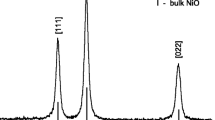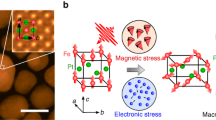Abstract
Magnetization reversal in magnetic particles is one of the fundamental issues in magnetic data storage. Technological improvements require the understanding of dynamical magnetization reversal processes at nanosecond time scales1. New strategies are needed to overcome current limitations. For example, the problem of thermal stability of the magnetization state (superparamagnetic limit) can be pushed down to smaller particle sizes by increasing the magnetic anisotropy2. High fields are then needed to reverse the magnetization, which are difficult to achieve in current devices. Here we propose a new method to overcome this limitation. A constant applied field, well below the switching field, combined with a radio-frequency (RF) field pulse can reverse the magnetization of a nanoparticle. The efficiency of this method is demonstrated on a 20-nm-diameter cobalt particle by using the microSQUID (superconducting quantum interference device) technique3. Other applications of this method might be nucleation or depinning of domain walls.





Similar content being viewed by others
References
Hillebrands, B. & Ounadjela, K. (eds) Spin Dynamic in Confined Magnetic Structures. (Springer, Berlin, 2002).
Sun, S., Murray, C.B., Weller, D., Folks, L. & Moser A. Monodisperse FePt nanoparticles and ferromagnetic FePt nanocrystal superlattices. Science 287, 1989–1992 ( 2000).
Wernsdorfer, W. Classical and quantum magnetization reversal studied in nanometer-sized particles and clusters. Adv. Chem. Phys. 118, 99–190 ( 2001).
Back, C.H. et al. Minimum field strength in precessional magnetization reversal. Science 285, 864–867 ( 1999).
Gerrits, Th., van den Berg, H.A.M., Hohlfeld, J., Bär, L. & Rasing, Th. Ultrafast precessional magnetization reversal by picosecond magnetic field pulse shaping. Nature 418, 509–511 ( 2002).
Kaka S. & Russek, S.E. Precessional switching of submicrometer spin-valves. Appl. Phys. Lett. 80, 2958–2960 ( 2002).
Schumacher, H.W. et al. Phase coherent precessional magnetization reversal in microscopic spin valve elements. Phys. Rev. Lett. 90, 17201 ( 2003).
Schumacher, H.W., Chappert, C., Sousa, R.C., Freitas, P.P. & Miltat, J. Quasiballistic magnetization reversal. Phys. Rev. Lett. 90, 017204 ( 2003).
Hillebrands, B. & Fassbender, J. Ultrafast magnetic switching. Nature 418, 493–494 ( 2002).
Myers, E.B., Ralph, D.C., Katine, J.A., Louie, R.N. & Buhrman, R.A. Current-induced switching of domains in magnetic multilayer devices. Science 285, 867–870 ( 1999).
Garcia-Palacios, J.L. & Lazaro, F.J. Langevin-dynamics study of the dynamical properties of small magnetic particles. Phys. Rev. B 58, 14937–14958 ( 1998).
Coffey, W.T. et al. Thermally activated relaxation time of a single domain ferromagnetic particle subjected to a uniform field at an oblique angle to the easy axis: Comparison with experimental observations. Phys. Rev. Lett. 80, 5655–5658 ( 1998).
Bauer, M., Fassbender, J., Hillebrands, B. & Stamps, R.L. Switching behavior of a Stoner particle beyond the relaxation time limit Phys. Rev. B 61, 3410–3416 ( 2000).
Stoner, E.C. & Wohlfarth, E.P. A mechanism of magnetic hysteresis in heterogeneous allows. Phil. Trans. R. Soc. Lond. A 240, 599–608 ( 1948).
Thiaville, A. Coherent rotation of magnetization in three dimensions: A geometrical approach. Phys. Rev. B 61, 12221–12232 ( 2000).
Wernsdorfer, W. et al. Experimental evidence of the Néel-Brown model of magnetization reversal. Phys. Rev. Lett. 78, 1791–1794 ( 1997).
Guerret-Piécourt, C., Le Bouar, Y., Loiseau, A. & Pascard, H. Relation between metal electronic-structure and morphology of metal-compounds inside carbon nanotubes. Nature 372, 761–765 ( 1994).
Wernsdorfer, W., Thirion, C., Demoncy, N., Pascard, H. & Mailly, D. Magnetisation reversal by uniform rotation (Stoner–Wohlfarth model) in fcc cobalt nanoparticles. J. Magn. Magn. Mater. 242–245, 132–137 ( 2002).
Bonet, E. et al. Three-dimensional magnetization reversal measurements in nanoparticles. Phys. Rev. Lett. 83, 4188–4191 ( 1999).
Schleicher, B. et al. Magnetization reversal measurements of size-selected iron oxide particles produced via an aerosol route. Appl. Organometall. Chem. 12, 315–320 ( 1998).
Thirion, C. et al. Micro-SQUID technique for studying the temperature dependence of switching fields of single nanoparticles. J. Magn. Magn. Mater. 242–245, 993–994 ( 2002).
Acknowledgements
This work was supported by the European Union network MASSDOTS. B. Barbara, A. Benoit, E. Bonet and H. Pascard are acknowledged for the continuous support of this research.
Author information
Authors and Affiliations
Corresponding author
Ethics declarations
Competing interests
The authors declare no competing financial interests.
Rights and permissions
About this article
Cite this article
Thirion, C., Wernsdorfer, W. & Mailly, D. Switching of magnetization by nonlinear resonance studied in single nanoparticles. Nature Mater 2, 524–527 (2003). https://doi.org/10.1038/nmat946
Received:
Accepted:
Published:
Issue Date:
DOI: https://doi.org/10.1038/nmat946
- Springer Nature Limited
We’re sorry, something doesn't seem to be working properly.
Please try refreshing the page. If that doesn't work, please contact support so we can address the problem.





